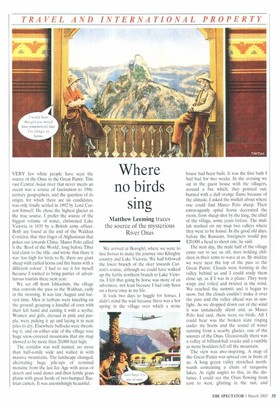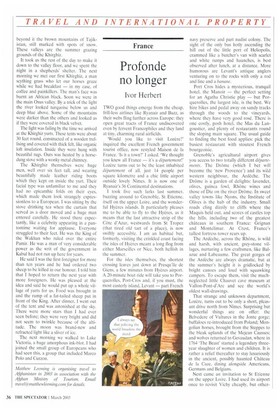Where no birds sing
Matthew Leeming traces the source of the mysterious River Oxus VERY few white people have seen the source of the Oxus in the Great Pamir. This vast Central Asian river that never meets an ocean was a source of fascination to 19thcentury geographers, and the question of its origin, for which there are six candidates, was only finally settled in 1892 by Lord Curzon himself. He chose the highest glacier as the true source. I prefer the source of the biggest volume of water, christened Lake Victoria in 1835 by a British army officer. Both are found at the end of the Wakhan Corridor, that thin finger of Afghanistan that pokes out towards China. Marco Polo called it the 'Roof of the World', long before Tibet laid claim to the title, and wrote that there it was 'too high for birds to fly, there are giant sheep with curled horns and fire burns with a different colour'. I had to see it for myself because I wanted to bring parties of adventurous tourists there next year.
We set off from Ishkashim, the village that controls the pass to the Wakhan, early in the morning. It was late August and harvest time. Men in turbans were kneeling on the ground, grasping a handful of corn with their left hand and cutting it with a scythe. Women and girls, dressed in pink and purple, were picking it up and laying it in neat piles to dry. Elsewhere bullocks were threshing it, and on either side of the village rose huge snow-covered mountains that my map showed to be more than 20,000 feet high.
The corridor was well named, no more than half-a-mile wide and walled in with massive mountains. The landscape changed, alternating huge pile-ups of terminal moraine from the last Ice Age with areas of desert and sand dunes and then fertile grass plains with great herds of two-humped Bactrian camels. It was astonishingly beautiful. We arrived at Boroghil, where we were to hire horses to make the journey into Khirghiz country and Lake Victoria. We had followed the lower branch of the river towards curzoo's source, although we could have walked up the fertile northern branch to Lake Victoria. I felt that going by horse was more of an adventure, not least because I had only been on a horse once in my life.
It took two days to haggle for horses, I didn't mind the wait because there was a hot spring in the village over which a stone house had been built. It was the first bath I had had for two weeks. In the evening we sat in the guest house with the villagers, around a fire which, they pointed out, burned with a dull orange flame because of the altitude. I asked the mullah about where one could find Marco Polo sheep. Their extravagantly spiral horns decorated the room, from sheep shot by the king, the chief of the village, some years before. The mullah marked on my map two valleys where they were to be found. In the good old days, before the Russians, foreigners would pay $20,000 a head to shoot one, he said.
The next day, the male half of the village came out to see us off, men holding children in their arms to wave at us. By midday we were near the top of the pass to the Great Pamir. Clouds were forming in the valley behind us and I could study them close up, as if I was in a plane. They were wispy and roiled and twisted in the wind. We reached the summit and it began to snow, but the clouds couldn't make it over the pass and the valley ahead was in sunlight. As we dropped down out of the wind it was unnaturally silent and, as Marco Polo had said, there were no birds. All I could hear was the broken slate ringing under my boots and the sound of water running from a nearby glacier, one of the sources of the Oxus. Occasionally there was a volley of billiard-ball cracks and a rumble as more boulders fell off the mountain.
The view was awe-inspiring. A map of the Great Pamir was spread out in front of us. A long green valley stretched northwards containing a chain of turquoise lakes. At right angles to this, in the distance, I could see the Oxus flowing from east to west, glinting in the sun, and beyond it the brown mountains of Tajikistan, still marked with spots of snow. These valleys are the summer grazing grounds of the Khirghiz.
It took us the rest of the day to make it down to the valley floor, and we spent the night in a shepherds' shelter. The next morning we met our first Khirghiz, a man scything grass who let our horses graze while we had breakfast — in my case, of coffee and painkillers. The man's face was burnt an African black. Soon we were in the main Oxus valley. By a trick of the light the river looked turquoise below us and deep blue above. Some of the mountains were darker than the others and looked as if they were covered in black velvet.
The light was failing by the time we arrived at the Khirghiz yurts. These tents were about 30 feet round, constructed of a wooden trellising and covered with thick felt, like organic loft insulation. Inside they were hung with beautiful rugs. Ours was heated by a horsedung stove with a wonky metal chimney.
The Khirghiz themselves were huge men, well over six feet tall, and wearing beautifully made leather riding boots which they kept on inside the yurt. Their facial type was unfamiliar to me and they had no epicanthic folds on their eyes, which made them look strangely expressionless to a European. I was sitting by the stove drinking tea when the curtain that served as a door moved and a huge man entered carefully. He stood there expectantly, like a celebrity appearing in a pantomime waiting for applause. Everyone struggled to their feet. He was the King of the Wakhan who ruled over the entire Pamir. He was a man of very considerable power as the writ of the government in Kabul had not run up here for years.
He said I was the first foreigner for more than ten years and he had ordered two sheep to be killed in our honour. I told him that I hoped to return the next year with more foreigners. He was pleased at the idea and said he would put up a whole village of yurts for us. Food was brought in and the rump of a fat-tailed sheep put in front of the King. After dinner, I went out of the tent and was astonished at the sky. There were more stars than I had ever seen before; they were very bright and did not seem to twinkle because of the altitude. The moon was brand-new and refracted light like a sliver of ice.
The next morning we walked to Lake Victoria, a huge amorphous ink-blot. I had joined the small group of Europeans who had seen this, a group that included Marco Polo and Curzon.



















































































 Previous page
Previous page